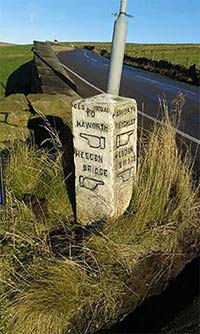Local History Society Report
Milestones and waymarkers in the South Pennines
Speaker:David Garside
Monday, 28 January 2019
 As we walk along country lanes, bridle paths and canal tow-paths we perhaps don’t always notoice the waymarkers and milestones that guided our forebears. When we do, we see their idiosyncracies: place names and distances carefully or crudely carved in the stone; the variations in shape and size; the neat little cuffed hands with a finger pointing us on our way. For David Garside, a member of the Yorkshire Milestones Society, the collecting and mapping of these wayside markers is a passion which he shared with a meeting of the Hebden Bridge Local History Society.
As we walk along country lanes, bridle paths and canal tow-paths we perhaps don’t always notoice the waymarkers and milestones that guided our forebears. When we do, we see their idiosyncracies: place names and distances carefully or crudely carved in the stone; the variations in shape and size; the neat little cuffed hands with a finger pointing us on our way. For David Garside, a member of the Yorkshire Milestones Society, the collecting and mapping of these wayside markers is a passion which he shared with a meeting of the Hebden Bridge Local History Society.
The earliest milestones found in Yorkshire are Roman. These are cylindrical stones, some with carved inscriptions but others just painted. Most of the 10 that remain are in museums, although one was discovered quite recently near Golcar.
David also pointed out the remains of wayside crosses that marked the cross roads and perhaps provided some religious solace to travellers. There are several of these on the ancient Long Causeway route between Heptonstall and Burnley. The area of the South Pennines around Hebden Bridge is particularly rich in old markers, perhaps because so many tracks and lanes have been undisturbed over the years.
The location of old markers allows something of the history of old roads to be tracked. The presence of waymarkers on remote moorland paths, such as Reaps Cross on Heptonstall moor, mark ways that were once important links between towns for the traders of the time. Many are simply tall standing stones, designed to keep the traveller on the right path in deep snow.
By the end of the 17th century it became the duty of the county justices to ensure that markers at cross roads were erected, and later to show distances to the next market town, and especially on the moors, where ‘intelligence is difficult to be had.’
One interesting milestone in Blackshaw Head not only points to Hebden Bridge and Halifax but also to ‘London, 206 miles’.
Some of the most detailed milestones are found on the turnpike roads, private enterprises designed to improve transportation and raise money for the founders. Many of these stones are triangular and show towns and distances on the two outward facing sides. These signs are reminders of how some roads which are now country lanes were the major arteries of the time.
By the end of the nineteenth century, County Councils took over responsibility for the roads and there was some standardisation of the milestone markers. The West Riding of Yorkshire commissioned over 600 metal plated stones, now known as Brayshaw-Booth markers. (Brayshaw was the metal worker; Booth provided the stone.) The markers had a triangular base and an arched upper part, and were originally painted in a smart blue and gold livery. They gave information about distances and also the location of the stone, recording in the landscape the names of some now forgotten townships.
David also showed pictures of some more unusual stones in Huddersfield which marked distances from the town rather than to it. These are thought to be unique and were used to indicate the correct fare for transporting people or goods from the town. Canal markers also often show the distance from a place, usually the starting point, probably for similar reasons.
David’s talk stimulated a lot of interest for people to search out some of these stone markers which seem to bring history into the present in a very solid form. Anyone interested can access maps which show the precise locations by visiting the Yorkshire Milestone Society website and clicking on ‘Find Yorkshire’s Milestones’.
The next meeting of the Hebden Bridge Local History Society on Wednesday 13th February, will hear Dr Stephen Caunce talk about the ‘History of farming in the industrial Pennines.’ On 27th February Hywel Lewis will share his research into the woodlands of this area. Meetings are held at Hebden Bridge Methodist Church and begin at 7.30. Everyone welcome.
With thanks to Sheila Graham for this report
Details of all the Society’s activities can be found on the website and you can also follow them on their Facebook page.
See also
The first few episodes of Gentleman Jack (screenplay: Sally Wainwright) were inspired by two books written by local historian Jill Liddington, including Nature's Domain published by Pennine Pens


